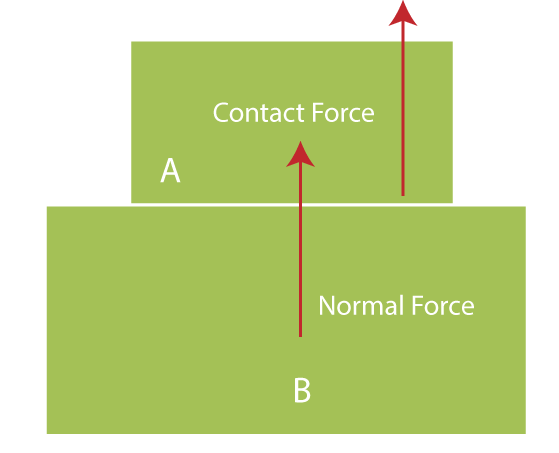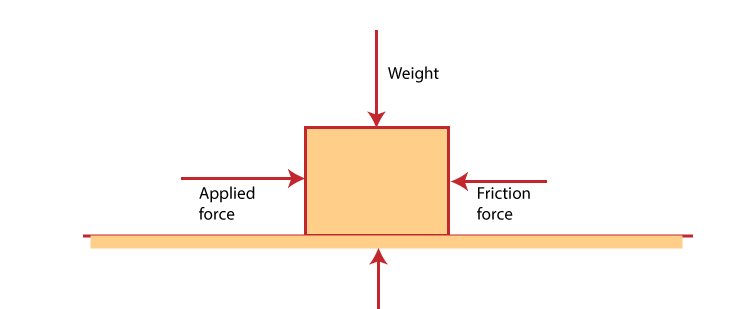Contact Force DefinitionIntroductionWhen we consider the many forces at work in our universe, we may consider how gravity pulls us downward or how magnets may either attract or repel one another. The force that results from actual physical contact between things is another sort of force that is quite significant in our daily lives. The term "contact forces" refers to this. 
Every time two things make direct physical touch with one another, contact forces are produced. When we walk on the ground, for instance, our feet make touch with the earth and we feel a contact force that propels us ahead. When we hold a pencil in our hand, the force of our grip is a contact force that keeps the pencil in place. Normal force, frictional force, tension force, and air resistance are a few of the several forms of contact forces. Each of these forces has a distinctive function in our daily lives and has the power to significantly alter how things move and interact with one another. Contact forces are a fundamental idea in physics and are crucial for comprehending how moving things behave. We may better comprehend the physical world around us and make defensible choices regarding how to design and construct items that interact with one another by studying the various contact forces and how they interact with one another. Importance of Contact Forces in PhysicsContact forces play a significant role in our lives and have a variety of effects on us. Contact forces are used in our running, jumping, sitting, and holding of items. For instance, when we sit on a chair, we encounter a typical force that prevents us from penetrating the surface of the chair. The contact between our body and the chair is what causes this natural force to exist. Similarly to this, when we hold anything in our hands, a contact force prevents the thing from slipping out of our hands. Contact between our fingers and the item we are holding creates a contact force. Everyday tasks like walking or carrying items would be difficult without these contact forces. Contact forces are significant for our comprehension of the natural world in addition to their practical uses. New materials and technologies that have revolutionized how we live and work have been found via the study of contact forces. For instance, the discovery of novel materials with reduced friction has resulted in the construction of machinery like engines and turbines that are more effective. Additionally, contact forces are very important in the planning and construction of buildings, bridges, and other structures. Engineers must consider the numerous contact forces, including normal forces, frictional forces, and tension forces, that will be applied to a structure over time. Designing buildings that can survive the test of time and continue to be safe for usage requires an understanding of how these forces interact with one another. In the study of physics, contact forces play a crucial role in understanding how things interact with one another. We can forecast how items will behave in a range of different settings by examining the various contact forces and how they impact objects in motion. For instance, when we walk on the ground, the normal force-a sort of contact force-pushes back on our feet and propels us ahead. We couldn't walk or move about in our environment without this force. Similarly to this, frictional forces are quite important for designing braking systems for cars. Engineers may create brakes that enable vehicles to stop fast and securely by understanding how friction influences the motion of things. In short, Contact forces are a fundamental idea in physics and are important for comprehending both the natural world and daily life. They are essential to our capacity to move and interact with items in our surroundings and play a crucial part in the design and construction of machinery, buildings, and other structures. We may learn more about the environment we live in and how to design and construct items that interact with one another by researching contact forces. 
Types of contact forces1. Normal ForcesDefinition: When an item comes into touch with another object, a contact force known as the normal force acts perpendicular to the surface of the first object. It results from the electromagnetic attraction of the atoms of the two in-touch objects. Examples: Placing an item on a surface is a popular way to see the normal force in action. The item experiences a normal force from the surface, which balances off the downward force of gravity. In order to keep us from sinking into the ground when we are standing on it, the earth applies a normal force to our feet. The normal force is crucial in maintaining the steady nature of objects in touch with one another. Pushing a door to open it is another way to experience the typical force. The door exerts an equal and opposite normal force on our hand as we press on it. We can push the door open because the normal force balances the force we are applying to the door. 2. Frictional ForceDefinition: One sort of contact force that results from the interaction of two surfaces in touch is the frictional force. In opposition to the relative motion or tendency of motion between the two surfaces, it acts parallel to the surface of contact. The imperfections or small bumps on an object's surface are what generate frictional force. These bumps interact with one another when two surfaces come into contact, producing a force that prevents mobility. The type of the surfaces, the force pressing them together, and the angle between the surfaces all affect how much friction there is between two surfaces. Examples: When we try to move a big object on the ground, we often experience frictional force. It is challenging to move the item because of the friction it creates with the earth. For this reason, we frequently employ wheels or lubricants to lower friction and make moving the object simpler. 3. Tension ForceDefinition: When a string, rope, or cable is drawn taut by opposing forces, tension force, a sort of contact force, is delivered through it. Equal in size but directed in the opposite direction as the force imparted to the string, it acts over its whole length. The electromagnetic interactions between the string or cable's molecules produce tension force. The molecules are forced apart when the string is tugged tightly, producing a force that is transferred throughout its whole length. Examples: When pulling a large object with a rope, we frequently experience tension force. When someone pulls on one end of the rope, the tension force is transferred via the rope to the item at the other end. Without any physical touch between the person and the object, the tension force enables the thing to be moved. 4. Air ResistanceDefinition: The interaction between an item and the air molecules in its surroundings causes air resistance, commonly referred to as drag force, which is a sort of contact force. It depends on a number of variables, including the item's speed, size, and form, as well as the air's density, and behaves in the opposite direction to the direction of motion of the object. The air molecules are pushed aside when an item passes through the air, causing a drag force that prevents the object from moving. Examples: We may see an everyday illustration of air resistance when we throw a ball into the air. The air resistance the ball encounters as it travels through the air causes it to slow down and finally come to a standstill. This is why throwing a ball farther than it has to go presents more of a challenge. The design and operation of airplanes must also take into account air resistance. Airplanes are made to fly as quickly and effectively as possible by minimizing air resistance. In order to minimize air resistance and enhance performance, engineers employ aerodynamics to create the geometry of the airplane and its wings. When we ride a bike, we experience air resistance yet again. Air resistance, which may be perceived as a hindrance to forward motion, is something that both our body and the bike encounter while we ride. Because air resistance increases with speed, riding a bike at greater speeds is more challenging. Applications of Contact Forces1. In Daily Life
2. In Sports
Frictional force, in addition, to contact forces, is important in football. For accurate and controlled ball control, the player's foot must be able to hold the ball due to frictional force. Additionally, the ball's trajectory and speed are impacted by air resistance, making it difficult for players to anticipate and modify their moves accordingly. Athletes must comprehend the various contact forces and how they interact in order to perform at their peak levels. Players can make tactical choices that can offer them an advantage over their rivals by being aware of the game's mechanics. 3. In Engineering
Building skyscrapers is another technical use of contact forces. Engineers must take into account a variety of contact forces, including the weight of the construction materials, wind, and even earthquakes while constructing a tall structure. Building skyscrapers requires a strong normal force because it supports the weight of the materials and keeps the structure steady. Frictional force, which keeps construction materials in place and prevents them from moving, is another factor that engineers must take into account. Engineers must also take into account air resistance, which may exert a force on the building and cause it to wobble in the wind, in addition, to contact forces. Engineers can build skyscrapers that are structurally sound and able to endure a variety of external stresses by understanding the many forms of contact forces and their relationships.
Next TopicEdema Definition
|
 For Videos Join Our Youtube Channel: Join Now
For Videos Join Our Youtube Channel: Join Now
Feedback
- Send your Feedback to [email protected]
Help Others, Please Share









